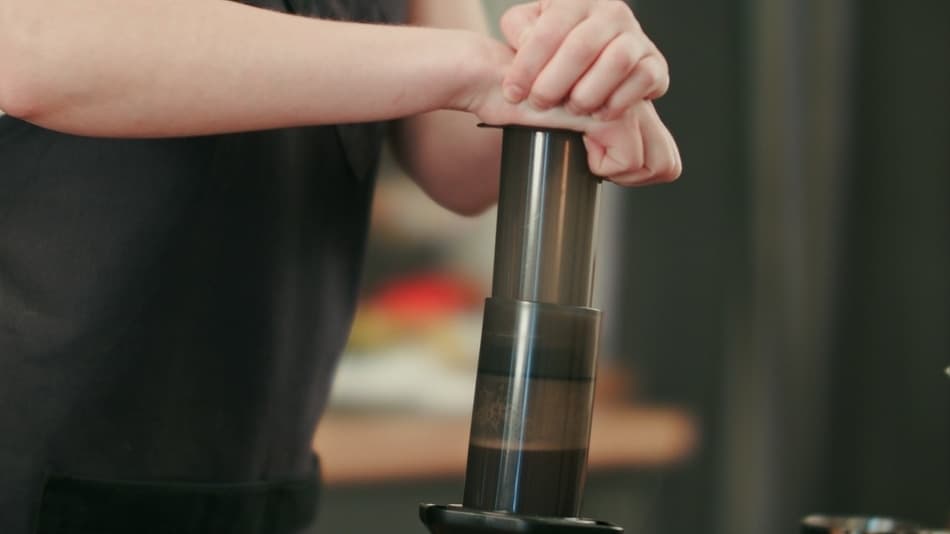Does AeroPress Make Really Espresso? (Truth Revealed!)

The AeroPress has to be the most versatile coffee maker that there is, which is why it’s so popular. But is the AeroPress capable of making espresso?
The AeroPress is not able to produce espresso as it lacks the essential features needed to produce it, which are only found in espresso machines. Espresso machines use 9 bars (130psi) of pressure, which is essential for producing true espresso. As the AeroPress only produces less than 1 bar, it cannot make espresso.
That’s certainly controversial stuff as a lot of websites claim that the AeroPress can indeed make espresso.
So, please allow me to explain why I disagree, and also let me also show you how you can easily adapt your AeroPress to make an espresso-like drink.
Why AeroPress can’t make espresso
In order to make a cup of espresso coffee, you need an espresso machine. Espresso machines operate unlike any other coffee maker. We’re going to look at three factors that are essential for real espresso coffee.
- High pressure
- Crema
- High extraction
AeroPress vs espresso: pressure
Espresso machines produce espresso coffee by forcing near-boiling, pressurised water through a compact ‘puck’ of finely ground coffee.
The pressure used by espresso machines can vary somewhat; however, the industry standard for most machines is nine bars (130psi) of pressure.[1]
The AeroPress is not able to produce anything like nine bars of pressure. This is what the official AeroPress website has to say about its achievable pressure levels:
The AeroPress filter is 2.5 inches in diameter so the area of the filter is 4.9 square inches. If you press down firmly on a scale, it is relatively easy to get the scale up to 25 pounds and then if you press hard on the scale, you can certainly get it up to 50 pounds.
Therefore if you press similarly hard on your AeroPress while brewing coffee, the firm pressing will be at 5.1 psi (25 lbs/4.9 sq in) and the harder pressing will be at 10.2 psi (50 lbs/4.9 sq in). Since a bar of pressure is 14.7 psi, the former is .35 bar and the latter is .70 bar.
AeroPress
The .35 to .70 bars (5-10 psi) of pressure produced by the AeroPress pales into comparison compared to an espresso machine.
The result of forcing water at such a high pressure through a tightly packed bed of ground coffee produces a coffee beverage with properties unique to espresso. Let’s take a look at one of these.
AeroPress vs espresso: crema
One of the defining features of espresso is the floating layer of tiny bubbles known as crema that sits proudly on the top of the cup.
When coffee is roasted, a large amount of carbon dioxide (CO2) builds up and becomes trapped within the cells of the coffee beans.
Whilst grinding the coffee releases a lot of the CO2 present in the beans, some of it is still retained inside the cell structure.
When filter coffee is prepared (such as AeroPress), the CO2 is quickly released when the ground coffee is combined with water. As the water is added to the coffee, the CO2 causes the coffee bed to expand and swell. This effect is referred to as a ‘bloom’.
However, in an espresso machine, there is nowhere for the CO2 to go, and so it gets forced through the portafilter basket along with everything else.[2]
Due to the high pressures used to make espresso, the process causes a by-product to form when the emulsified coffee oils are released and come into contact with the oxygen in the air. This something unique to espresso preparation.
The by-product is known as crema. Crema is a layer of wet foam that consists of tiny sphere-shaped gas bubbles that floats on the top of espresso coffee.[3]
The espresso crema is comprised of thousands of tiny bubbles of CO2 gas that are suspended in water. These bubbles attach to the oils and fats present in coffee, rising to the top of the beverage.[4]
The reason that the crema floats is because it’s hydrophobic, meaning that it repels water. This causes the crema to rise to the top and bind with the oxygen in the air.
As the AeroPress is only capable of .35 bars, this explains why you cannot achieve crema using an AeroPress.[5]
Yes, your AeroPress does produce some foamy bubbles on top of your drink, but this is not the crema that’s found in espresso. Crema is an integral part of espresso, making up around 10 percent of its volume.
So in truth, the AeroPress can produce a very strong cup of coffee, but it could never match up to the espresso machine. So what’s the difference between AeroPress and espresso in terms of strength?
AeroPress vs espresso: extraction
Another defining feature of espresso is how incredibly concentrated it is. Filter coffee made using brewers such as the AeroPress contains very little soluble coffee solids. In fact, a typical cup is over 98 percent water.[6]
The espresso machine is capable of producing a cup of coffee that contains a whopping 10 percent of soluble coffee solids, meaning that it’s 90 percent water.[7]
Despite the fact that the AeroPress does a great job of making a concentrated brew, it could never achieve the likes of a 10 percent extraction. The high extraction is only possible because of the force of the pressurised water used by espresso machines.
The large quantity of soluble coffee and oils present in espresso give it that huge body and mouthfeel. The concentration of espresso is so strong that a single shot can withstand being drowned in 300ml milk, which is why it’s the coffee beverage of choice for milk-based drinks.
But it’s not all bad news AeroPress/espresso front. There is one particular aftermarket product which aids in producing espresso-like drinks called the Prismo.
With a few hacks, you can definitely make a cup of coffee that rivals the espresso. First of all, let me tell you what the Prismo is, and then I’ll explain how you can make espresso-like coffee easily at home using your AeroPress.
Fellow Prismo
The Fellow Prismo is an aftermarket filter and lid attachment specially made for the AeroPress. It has a pressure-actuated valve that allows for an increased build-up of pressure compared to the normal AeroPress lid.
The reusable 150-micron filter eliminates the need for a paper filter. This is great news as the lack of paper means the oils in the coffee can pass through, something that normally is stopped by paper filters.
This all goes towards providing that mouthfeel that we so much enjoy from a cup of espresso.
The Prismo also has a no-drip seal, meaning that you can brew with your AeroPress in the conventional way without worry of the liquid dripping through. This is also good news if you want to make cold brew in your AeroPress.
The no-drip seal is ideal for making espresso-like coffee as having to flip over an inverted AeroPress makes a real mess of the brewing process.
The Fellow Prismo is excellently well made and feels like it’s built to last. That’s definitely not something you can say for a lot of the other aftermarket metal filters out there.
The Fellow Prismo is also great for when you’re on a trip and you need to pack light. Not having to fuss around with paper filters is one less thing to worry about using the reusable Prismo filter.
Aeropresso: Espresso-like coffee with the AeroPress
Here’s our recipe for something that will get you as close as possible to espresso using your AeroPress.
You’ll need something that’s around the same circumference as the AeroPress chamber in order to tamp the ground coffee. This is the technique used in espresso preparation to build up pressure.
A small plastic tub such as a spice pot is a good option.
Equipment
- AeroPress
- Fellow Prismo
Method
- Attach the Prismo to your AeroPress.
- Put your water on to boil.
- Place the AeroPress over a very sturdy mug (do not to use glass).
- Measure out a dose of ground coffee (espresso fineness), and add to the AeroPress. Use around 16g – 20g of coffee.
- Wet two AeroPress filter papers and attach them to the base of your tamping device.
- Insert the tamper and push down on the coffee. Remove the tamper by twisting it as you lift it out.
- Pour over 80ml of freshly boiled water. If you’ve tamped correctly, the water will sit on top of the paper filter.
- Now press the plunger slowly. Aim to push through all the water within 30 seconds.
And voilà , you’ve just made yourself a cup of aeropresso. To make your aeropresso, you’ll want some top-quality coffee beans.







